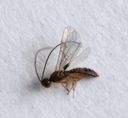Doryctinae
Doryctinae
Classification
- Phylum: Arthropoda
- Subphylum: Hexapoda
- Class: Insecta
- Order: Hymenoptera
- Superfamily: Ichneumonoidea
- Family: Braconidae
- Subfamily: Doryctinae
Pronunciation
How to pronounce Doryctinae: //dɔːˈrɪktɪniː//
These audio files are automatically generated. While they are not always 100% accurate, they are a good starting point.
Images



Summary
The Doryctinae are a diverse subfamily of parasitoid wasps within the Braconidae family, with members known for their role as biocontrol agents against wood-boring pests. They exhibit a wide range of sizes and some species lack wings, which affects their behavior and ecology.
Physical Characteristics
Doryctine wasps range in size from 1 to 25 mm, with small species having relatively large heads and slender elongated bodies. They typically exhibit small or reduced wings; many species are unable to fly or lack wings altogether. A characteristic feature is a row of stout spines along the foreleg tibia and a cyclostome depression above the mandibles.
Identification Tips
Identification can be made based on the presence of stout spines on the protibia, a flange on the propleuron above the forecoxa, and a double node near the apex of the dorsal valve of the ovipositor.
Habitat
Doryctinae are found in varied habitats, predominantly where wood-boring beetles and their larvae exist due to their parasitic life cycle.
Distribution
Doryctinae have a worldwide distribution, with the exception of polar regions.
Diet
Larvae of Doryctinae are parasitoids that feed on larvae of beetles, sawflies, and some moths. Some species also feed on seeds.
Life Cycle
Doryctinae undergo a parasitic life cycle where the female lays an egg after paralyzing the host larva through venom injection via her ovipositor. The larvae then develop within the host.
Reproduction
Reproduction involves the female Doryctinae injecting venom into a host larva, paralyzing it, and then laying an egg inside or near the host.
Ecosystem Role
Doryctinae play a significant role in controlling pest populations as many species are used in biological control programs.
Economic Impact
Doryctinae, particularly Spathius agrili, have significant economic importance as biological control agents against pests like the emerald ash borer in the United States and eucalyptus pests in Australia.
Evolution
Doryctinae is part of the cyclostome group, which includes several other subfamilies within Braconidae.
Similar Taxa
Tags
- Doryctinae
- Braconidae
- parasitoid wasps
- ecological control